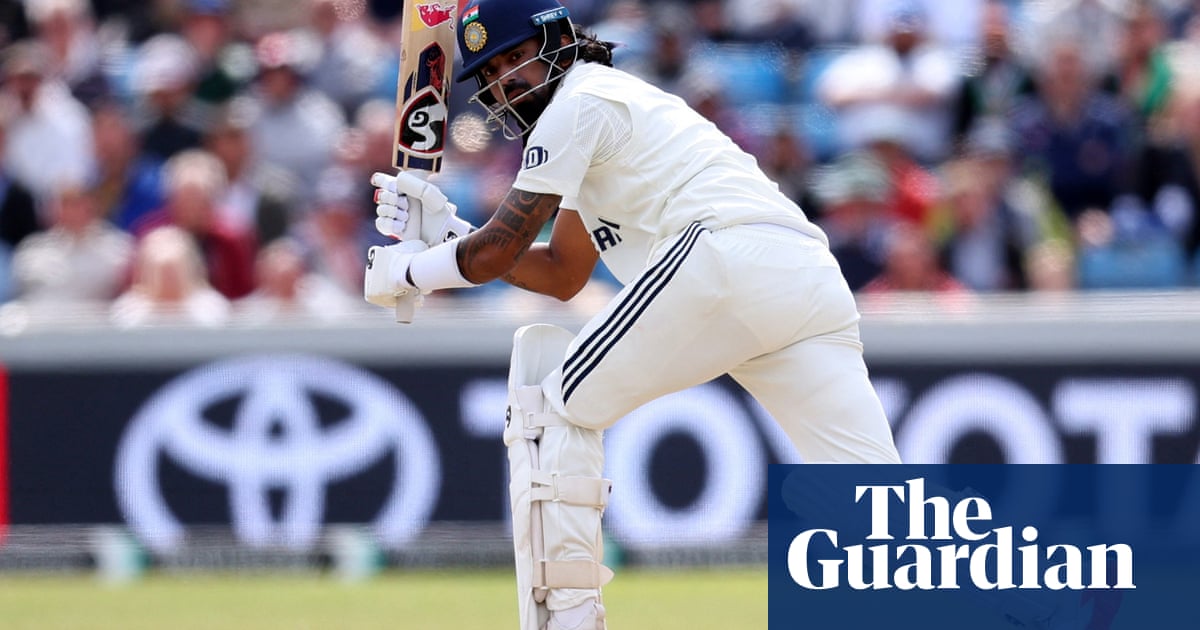Just 10 balls had been delivered on this fourth day, England had started brightly and had been buoyed by the wicket of India’s captain. For the batters a time perhaps for a little caution. At which point the freshly arrived Rishabh Pant faced his second delivery, bowled by Chris Woakes, hared down the pitch and swung his bat like a particularly clueless novice golfer, the ball spinning off the outside edge and flying over the slips and away for four.
From the crowd the reflexive reaction was laughter, not inappropriately given this was the kind of behaviour normally associated less with people wearing cricket whites and more with those sporting outsize shoes, a red nose and plenty of face paint.
There were plenty more ludicrous moments on Pant’s way to asecond century of the game, an innings in which the only temptation he did not give in to was the one to perform celebratory acrobatics on reaching triple figures. But if his would have been the name on supporters’ lips as they headed out of the gates at the close, the innings put together by the man at the other end was, in an infinitely less showy way, more interesting still – not just because of its quality but because of its contrast, KL Rahul cast perfectly in the role of anti‑Pant.
The 33-year-old is by nature particularly well suited to batting with such showmen: there is no need to take any risks when the man at the other end is taking enough for two, and no reason for flamboyance when your partner is so prone to a dance and a swing. He managed to contrast not just with his teammate but even with himself, looking like a rock star, long hair spilling out of his helmet and over his collar, while playing like a maths nerd, all precise angles and economy of force; combining gloriously streamlined, economical movement with what sometimes appears an asinine stubbornness when it comes to budging the scoreboard.
This can be seen as a failing, and he has a reputation for losing his way during innings, going through prolonged funks during which the possibility of run-scoring becomes little more than notional. Famously, talking about Twenty20 games, he once insisted that “strike rates are very, very overrated” – which, given that it is a format in which success is predicated entirely on fast scoring, raised a few hackles (he has, to be fair, also scored the joint second-fastest 50 in Indian Premier League history). Kevin Pietersen once compared the spectator experience when Rahul is at the crease to watching paint dry. “For me,” Rahul said in that discussion of strike rates, “it’s only about how I can win games for my team.” Here he played from the start as if he knew precisely which path would guide his team towards victory, and he might just have judged it perfectly.
For the first hour of this fourth day it was also a path he negotiated very carefully. England sustained their bright start for the full hour, spirits replenished overnight, game in the balance, energy in the field, Brydon Carse straddling it with an outstanding spell. He, and later Ben Stokes, repeatedly located a spot, conveniently positioned if bowling over the wicket from the Kirkstall Lane end towards a right-hander, off which the ball could be relied upon to bounce unreliably, which the left-handed Pant was never bothered by but which allowed Rahul to demonstrate the lightning speed of his reactions. Those same reflexes also allowed him, when the ball behaved less wildly, to appear completely unhurried in his strokeplay. Rahul faced 43 balls in that hour, scoring just seven, before the smoothest of accelerations: 18 off 38 in the second hour of the day, 28 off 45 in the third, 20 off 25 in the fourth (though of course run rates are very, very overrated).
There were inevitable, and very occasional, imperfections, and three times he edged the ball in inconvenient directions: on 58, off Josh Tongue, high to Harry Brook at gully – who got two palms on it but could not hold on – on 71, off Stokes, into a particularly sensitive area of his own body, and then that final attempt to cut Carse that sent the ball into his own stumps, by which time he hadscored 137and slowly, stylishly shunted the match in his team’s favour.
Sign up toThe Spin
Subscribe to our cricket newsletter for our writers' thoughts on the biggest stories and a review of the week’s action
after newsletter promotion
And along the way such handsome highlights: leaning back to dab Tongue wide of slip, waiting to the last possible moment to cut Carse with a surgeon’s precision into the gap between gully and backward point, or pulling the same bowler, again waiting, late enough that the few remaining sceptics suggested it was more accident than design, to open up the perfect angle. He became just the sixth Indian to score three Test centuries in this country, having spent the crucial part of his innings in partnership with the fifth. Turns out there are similarities between him and Pant after all.
